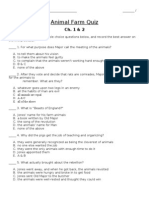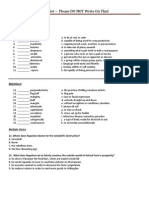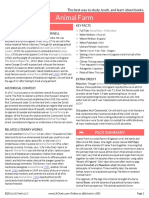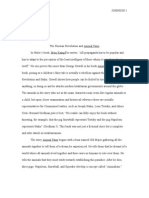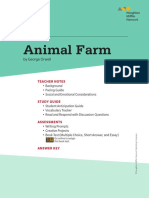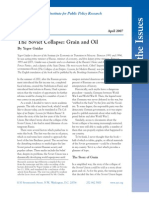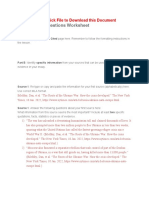Character Profiles Animal Farm
Character Profiles Animal Farm
Uploaded by
ar44Copyright:
Available Formats
Character Profiles Animal Farm
Character Profiles Animal Farm
Uploaded by
ar44Copyright
Available Formats
Share this document
Did you find this document useful?
Is this content inappropriate?
Copyright:
Available Formats
Character Profiles Animal Farm
Character Profiles Animal Farm
Uploaded by
ar44Copyright:
Available Formats
Character Profiles
Mr. Jones:
Orwell’s villain (before Napoleon)
Once was a good master of the farm but let the farm fall into bad
times.
Represents the last of the czars, Czar Nicholas II, the leader
before Stalin (Napoleon) and s represents the old government,
the last of the Czars.
Falls into drinking and becomes slack.In fact, he and his men
had taken up the habit of drinking. Old Major reveals his feelings
about Jones and his administration when he says, "Man is the
only creature that consumes without producing. He does not give
milk, he does not lay eggs, he is too weak to pull the plough , he
cannot run fast enough to catch rabbits. Yet he is lord of all the
animals. He sets them to work, he gives back to them the bare
minimum that will prevent them from starving and the rest he
keeps for himself."
So Jones and the old government are successfully uprooted by
the animals. Little do they know, history will repeat itself with
Napoleon and the pigs.
Old Major: Old Major is the first major character described by
Orwell in Animal Farm. This "purebred" of pigs is the kind, grand
fatherly philosopher of change— an obvious metaphor for Karl
Marx. Old Major proposes a solution to the animals' desperate
plight under the Jones "administration" when he inspires a
rebellion of sorts among the animals. Of course the actual time
of the revolt is unsaid. It could be the next day or several
generations down the road. But old Major's philosophy is only
an ideal.
After his death, three days after the barn-yard speech, the
socialism he professes is drastically altered when Napoleon and
the other pigs begin to dominate. It's interesting that Orwell does
not mention Napoleon or Snowball anytime during the great
speech of old Major. This shows how distant and out-of-touch
they really were; the ideals old Major proclaimed seemed to not
even have been considered when they were establishing their
new government after the successful revolt. It almost seemed as
though the pigs fed off old Major's inspiration and then used it to
benefit themselves (a interesting twist of capitalism) instead of
following through on the old Major's honest proposal. This could
be Orwell's attempt to dig Stalin, who many consider to be
someone who totally ignored Marx's political and social theory.
Using old Major's seeming naivety, Orwell concludes that no
society is perfect, no pure socialist civilization can exist, and
there is no way to escape the evil grasp of capitalism. (More on
this in the Napoleon section.) Unfortunately when Napoleon
and Squealer take over, old Major becomes more and more a
distant fragment of the past in the minds of the farm animals.
Moses: Moses is perhaps Orwell's most intriguing character in
Animal Farm. This raven, first described as the "especial pet" of
Mr. Jones, is the only animal who doesn't work. He's also the
only character who doesn't listen to Old Major's speech of
rebellion.
Orwell narrates, "The pigs had an even harder struggle to
counteract the lies put about by Moses, the tame raven. Moses,
who was Mr. Jones's especial pet, was a spy and a tale-bearer,
but he was also a clever talker. He claimed to know of the
existence of a mysterious country called Sugarcandy Mountain,
to which al animals went when they died. It was situated
somewhere up in the sky, a little distance beyond the clouds,
Moses said. In Sugarcandy Mountain it was Sunday seven days
a week, clover was in season all the year round, and lump sugar
and linseed cake grew on the hedges. The animals hated
Moses because he told tales and did no work but some of them
believed in Sugarcandy Mountain, and the pigs had to argue
very hard to persuade them that there was no such place."
Moses represents Orwell's view of the Church. To Orwell, the
Church is just used as a tool by dictatorships to keep the working
class of people hopeful and productive. Orwell uses Moses to
criticize Marx's belief that the Church will just go away after the
rebellion. Jones first used Moses to keep the animals working,
and he was successful in many ways before the rebellion. The
pigs had a real hard time getting rid of Moses, since the lies
about Heaven they thought would only lead the animals away
from the equality of socialism. But as the pigs led by Napoleon
become more and more like Mr. Jones, Moses finds his place
again. After being away for several years, he suddenly returns
and picks up right where he left off. The pigs don't mind this
time because the animals have already realized that the
"equality" of the revolt is a farce. So Napoleon feeds Moses with
beer, and the full-circle is complete.
Orwell seems to offer a very cynical and harsh view of the
Church. This proves that Animal Farm is not simply an anti-
communist work meant to lead people into capitalism and
Christianity. Really Orwell found loop-holes and much hypocrisy
in both systems. It's interesting that recently in Russia the
government has begun to allow religion again. It almost seems
that like the pigs, the Kremlin officials of today are trying to keep
their people motivated, not in the ideology of communism, but in
the "old-fashioned" hope of an after-life.
Snowball: Orwell describes Snowball as a pig very similar to
Napoleon— at least in the early stages. Both pigs wanted a
leadership position in the "new" economic and political system
(which is actually contradictory to the whole supposed system of
equality). But as time goes on, both eventually realize that one of
them will have to step down. Orwell says that the two were
always arguing. "Snowball and Napoleon were by far the most
active in the debates. But it was noticed that these two were
never in agreement: whatever suggestion either of them made,
the other could be counted to oppose it." Later, Orwell makes the
case stronger. "These two disagreed at every point
disagreement was possible."
Soon the differences, like whether or not to build a windmill,
become too great to deal with, so Napoleon decides that
Snowball must be eliminated. It might seem that this was a
spontaneous reaction, but a careful look tells otherwise.
Napoleon was setting the stage for his own domination long
before he really began "dishing it out" to Snowball. For example,
he took the puppies away from their mothers in efforts to
establish a private police force. These dogs would later be used
to eliminate Snowball, his arch-rival.
Snowball represents Trotsky, the arch-rival of Stalin in Russia.
The parallels between Trotsky and Snowball are uncanny.
Trotsky too, was exiled, not from the farm, but to Mexico, where
he spoke out against Stalin. Stalin was very weary of Trotsky,
and feared that Trotsky supporters might try to assassinate him.
The dictator of Russia tried hard to kill Trotsky, for the fear of
losing leadership was very great in the crazy man's mind.
Trotsky also believed in Communism, but he thought he could
run Russia better than Stalin. Trotsky was murdered in Mexico
by the Russian internal police, the NKVD-the pre-organization of
the KGB. Trotsky was found with a pick axe in his head at his
villa in Mexico.
Napoleon: Napoleon is Orwell's chief villain in Animal Farm.
The name Napoleon is very coincidental since Napoleon, the
dictator of France, was thought by many to be the Anti-Christ.
Napoleon, the pig, is really the central character on the farm.
Obviously a metaphor for Stalin, Comrade Napoleon represents
the human frailties of any revolution. Orwell believed that
although socialism is good as an ideal, it can never be
successfully adopted due to uncontrollable sins of human nature.
For example, although Napoleon seems as first to be a good
leader, he is eventually overcome by greed and soon becomes
power-hungry. Of course Stalin did too in Russia, leaving the
original equality of socialism behind, giving himself all the power
and living in luxury while the common peasant suffered. Thus,
while his national and international status blossomed, the welfare
of Russia remained unchanged. Orwell explains, "Somehow it
seemed as though the farm had grown richer without making the
animals themselves any richer--except, of course for the pigs
and the dogs."
The true side of Napoleon becomes evident after he
slaughters so many animals for plotting against him. He even
hires a pig to sample his food for him to make certain that no one
is trying to poison him. Stalin, too, was a cruel dictator in
Russia. After suspecting many people in his empire to be
supporters of Trotsky (Orwell's Snowball), Stalin systematically
murders many.
By the end of the book, Napoleon doesn't even pretend to
lead a socialist state. After renaming it a Republic and instituting
his own version of the commandments and the Beasts of
England, Comrade Napoleon, he quickly becomes more or less
a dictator who of course has never even been elected by the
animals.
Boxer: The name Boxer is cleverly used by Orwell as a
metaphor for the Boxer Rebellion in China in the early twentieth
century. It was this rebellion which signaled the beginning of
communism in red China. This communism, much like the
distorted Stalin view of socialism, is still present today in the
oppressive social government in China. Boxer and Clover are
used by Orwell to represent the proletariat, or unskilled labor
class in Russian society. This lower class is naturally drawn to
Stalin (Napoleon) because it seems as though they will benefit
most from his new system. Since Boxer and the other low
animals are not accustomed to the "good life," they can't really
compare Napoleon's government to the life they had before
under the czars (Jones). Also, since usually the lowest class has
the lowest intelligence, it is not difficult to persuade them into
thinking they are getting a good deal.
The proletariat is also quite good at convincing each other
that communism is a good idea. Orwell supports this contention
when he narrates, "Their most faithful disciples were the two
carthorses, Boxer and Clover. Those two had great difficulty in
thinking anything out for themselves, but having once accepted
the pigs as their teachers, they absorbed everything that they
were told, and passed it on to the other animals by simple
arguments."
Later, the importance of the proletariat is shown when Boxer
suddenly falls and there is suddenly a drastic decrease in work
productivity. But still he is taken for granted by the pigs, who
send him away in a glue truck. Truly Boxer is the biggest poster-
child for gullibility.
Squealer: Squealer is an intriguing character in Orwell's Animal
Farm. He's first described as a manipulator and persuader.
Orwell narrates, "He could turn black into white." Many critics
correlate Squealer with the Pravda, the Russian newspaper of
the 1930's. Propaganda was a key to many publications, and
since their was no television or radio, the newspaper was the
primary source of media information. So the monopoly of the
Pravda was seized by Stalin and his new Bolshevik regime.
In Animal Farm, Squealer, like the newspaper, is the link
between Napoleon and other animals. When Squealer masks
an evil intention of the pigs, the intentions of the communists can
be carried out with little resistance and without political disarray.
Squealer is also thought by some to represent Goebbels, who
was the minister of propaganda for Germany. This would seem
inconsistent with Orwell's satire, however, which was suppose to
metaphor characters in Russia.
Mollie: Mollie is one of Orwell's minor characters, but she
represents something very important. Mollie is the animal who
is most opposed to the new government under Napoleon. She
doesn't care much about the politics of the whole situation; she
just wants to tie her hair with ribbons and eat sugar, things her
social status won't allow. Many animals consider her a trader
when she is seen being petted by a human from a neighboring
farm. Soon Mollie is confronted by the "dedicated" animals, and
she quietly leaves the farm. Mollie characterizes the typical
middle-class skilled worker who suffers from this new
communism concept. No longer will she get her sugar (nice
salary) because she is now just as low as the other animals, like
Boxer and Clover.
Orwell uses Mollie to characterize the people after any
rebellion who aren't too receptive to new leaders and new
economics. There are always those resistant to change. This
continues to dispel the believe Orwell hated that basically all
animals act the same. The naivety of Marxism is criticized—
socialism is not perfect and it doesn't work for everyone.
Benjamin: Old Benjamin, an elderly donkey, is one of Orwell's
most elusive and intriguing characters on Animal Farm. He is
described as rather unchanged since the rebellion. He still does
his work the same way, never becoming too exited or too
disappointed about anything that has passed. Benjamin
explains, "Donkeys live a long time. None of you has ever
seen a dead donkey."
Although there is no clear metaphoric relationship between
Benjamin and Orwell's critique of communism, it makes sense
that during any rebellion there or those who never totally
embrace the revolution— those so cynical they no longer look to
their leaders for help. Benjamin symbolizes the older generation,
the critics of any new rebellion. Really this old donkey is the only
animal who seems as though he couldn't care less about
Napoleon and Animal Farm. It's almost as if he can see into
the future, knowing that the revolt is only a temporary change,
and will flop in the end.
Benjamin is the only animal who doesn't seem to have
expected anything positive from the revolution. He almost
seems on a whole different maturity lever compared to the other
animals. He is not sucked in by Napoleon's propaganda like the
others. The only time he seems to care about the others at all is
when Boxer is carried off in the glue truck. It's almost as if the
old donkey finally comes out of his shell, his perfectly fitted
demeanor, when he tries to warn the others of Boxer's fate. And
the animals do try to rescue Boxer, but it's too late. Benjamin
seems to be finally confronting Napoleon and revealing his
knowledge of the pigs' hypocrisy, although before he had been
completely independent.
After the animals have forgotten Jones and their past lives,
Benjamin still remembers everything. Orwell states, "Only old
Benjamin professed to remember every detail of his long life and
to know that things never had been, nor ever could be much
better or much worse— hunger, hardship, and disappointment
being, so he said, the unalterable law of life."
Muriel: Muriel is a knowledgeable goat who reads the
commandments for Clover. Muriel represents the minority of
working class people who are educated enough to decide things
for themselves and find critical and hypocritical problems with
their leaders. Unfortunately for the other animals, Muriel is not
charismatic or inspired enough to take action and oppose
Napoleon and his pigs.
Pigs: Orwell uses the pigs to surround and support Napoleon.
They symbolize the communist party loyalists and the friends of
Stalin. The pigs, unlike other animals, live in luxury and enjoy
the benefits of the society they help control. The inequality and
true hypocrisy of communism is expressed here by Orwell, who
criticized Marx's oversimplified view of a socialist, "utopian"
society. Obviously George Orwell doesn't believe such a society
can exist.
Toward the end of the book, Orwell emphasizes, "Somehow it
seemed as though the farm had grown richer without making the
animals themselves any richer— except, of course, the pigs and
the dogs."
Dogs: Orwell uses the dogs in his book, Animal Farm, to
represent the KGB or perhaps more accurately, the bodyguards
of Stalin. The dogs are the arch-defenders of Napoleon and the
pigs, and although they don't speak, they are definitely a force
the other animals have to contend with.
Orwell almost speaks of the dogs as mindless robots, so
dedicated to Napoleon that they can't really speak for
themselves. This contention is supported as Orwell describes
Napoleon's early and suspicious removal of six puppies from
their mother. The reader is left in the dark for a while, but later is
enlightened when Orwell describes the chase of Snowball.
Napoleon uses his "secret dogs" for the first time here; before
Snowball has a chance to stand up and give a counter-argument
to Napoleon's disapproval of the windmill, the dogs viciously
attack the pig, forcing him to flee, never to return again.
Orwell narrates, "Silent and terrified, the animals crept back
into the barn. In a moment the dogs came bounding back. At
first no one had been able to imagine where these creatures
came from, but the problem was soon solved: they were the
puppies whom Napoleon had taken away from their mothers and
reared privately. Though not yet full-grown, they were huge
dogs, and as fierce-looking as wolves. They kept close to
Napoleon. It was noticed that they wagged their tails to him in
the same way as the other dogs had been used to do to Mr.
Jones."
The use of the dogs begins the evil use of force which helps
Napoleon maintain power. Later, the dogs do even more
dastardly things when they are instructed to kill the animals
labeled "disloyal."
Stalin, too, had his own special force of "helpers." Really
there are followers loyal to any politician or government leader,
but Stalin in particular needed a special police force to eliminate
his opponents. This is how Trotsky was killed.
Animals: The sheep and other animals are very similar to Boxer
and Clover. Both the horses and sheep represent in many ways
the proletariat, or working class of unskilled laborers. These
animals depend on their backs, not their brains, to do work.
Thus, they fall into the bottom of society and are the focal point
of politicians' brainwashing.
The animals are stubborn and easily swayed. Orwell points
out repeatedly that if it wasn't for the bleating of the sheep, "Two
legs bad, four legs good," which was strategically inspired by the
pigs, Napoleon wouldn't have the power and control that he
eventually came to enjoy and then abuse.
Frederick: The theme of the gun and flag rituals performed by
the animals at the urging of Napoleon is strengthened through
Orwell's description of Mr. Frederick, the neighbor of Animal
Farm. Frederick, through the course of the book, becomes an
enemy and then a friend and then an enemy again to Napoleon,
who makes many secret deals and treaties with him. One of the
major problems the two farms have is the issue of the timber.
Napoleon sells the wood to Frederick for bank notes, only to find
that they are worthless. During the world wide depression,
countries were forced by necessity to trade with other countries.
One country would have a product or natural resource another
country would not; therefore to survive, the country would trade.
Many times the trades were unfair and fraudulent. This created
many international problems. So you can see the parallels are
clear.
Pilkington: Orwell uses Pilkington, another neighbor of Animal
Farm, as a metaphor for the Allies of World War II (excluding, of
course Russia). Like the Soviet Union before World War II,
Animal Farm wasn't sure who their allies would be. But after
losing the relationship with Frederick (Germany), Napoleon
(Stalin) decides to befriend Pilkington, and ally with him.
Napoleon and the other pigs even go as far as to invite him over
for dinner at the end of the book. Here Mr. Pilkington and his
men congratulate Napoleon on the efficiency of Animal Farm.
Orwell narrates, "Mr. Pilkington once again congratulated the
pigs on the low rations, the long working hours, and the general
absence of pampering which he had observed on Animal
Farm." Russia's allies, after the war, also admired it's
efficiency. But soon the cold war would begin between the
United States and Russia. This is unbelievably also referred to
in the book (published in 1946) when Orwell writes, "An uproar of
voices was coming from the farmhouse...a violent quarrel was in
progress. There were shouting, banging on the table, sharp
suspicious glances, furious denials." Amazingly Orwell seemed
to sense the start of American-Russian tension for years to
come.
Rats: Orwell's rats (and the other wild animals, like rabbits, for
that matter) represent the opposition to the Bolsheviks. They
too, had to be included in the rebellion, although for the longest
time they sided with the another party. The rats and rabbits
symbolize other political parties. Although the communist party
took off with Lenin, there were still others around. These are the
wild animals.
Pigeons: The pigeons symbolize Soviet propaganda, not to
Russia, but to other countries, like Germany, England, France,
and even the United States. Russia had created an iron curtain
even before WWII. The Communist government raved about its
achievements and its advanced technology, but it never allowed
experts or scientists from outside the country to check on its
validity. Orwell mentions the fact that the other farmers became
suspicious and worried when their animals began to sing Beasts
of England. Many Western governments have gone through a
similar problem with their people in this century. There was a
huge "Red Scare" in the United States in the 20's. In the 1950's
in the United States, Joseph McCarthy was a legislative member
of the government from Wisconsin. He accused hundreds of
people of supporting the Communist regime, from famous actors
in Hollywood to middle-class common people. The fear of
communism became a phobia in America and anyone speaking
out against the government was a suspect.
1. How much work are the animals now doing? (The
animals still believe they are working for themselves.
Although they
already work a sixty-hour week during spring and
summer, Napoleon informs them they can volunteer
for Sunday
afternoon work as well. However, any animal not
volunteering will have his rations cut in half.)
2. Why does Napoleon decide to engage in trade with
neighboring farms? (Because certain items such as
paraffin oil and
dog biscuits are in short supply, Napoleon decides to
sell a stack of hay and part of the wheat crop. Later
they may have
to sell some of the hens’ eggs.)
3. How do the animals react? (They are troubled and
think they remember a resolution against trade with
humans. Four
young pigs try to protest but are silenced by the
dogs’ growls and the sheep’s bleating of the slogan,
“Four legs good, two
legs bad.” Squealer later explains the decision and
asks if they have seen such a resolution written
down, but no such
record is found.)
4. How is the windmill destroyed? Why does Napoleon
blame Snowball? (A violent November storm blows it
down. Instead
of admitting that the windmill’s walls were not thick
enough to support it against a strong wind, Napoleon
blames
Snowball for blowing it up. Since Snowball had drawn
up the plans, the blame for its failure is partly his.)
5. Why does Napoleon insist the windmill must be
rebuilt immediately? (Napoleon probably had many
reasons, including
preventing the animals from becoming too
discouraged to begin building if they wait until
spring. By keeping the animals
busy building a windmill that will supposedly ease all
their lives, the animals will forget how miserably cold
and hungry
they are during the hard winter.)
6. Why does Napoleon order that the hens’ eggs be
sold? (The animals are nearly starving and there is
almost no food left.
The hens must give up their eggs for sale so that
meal and grain can be purchase for the good of all.)
A Teacher’s Guide to the Signet Classic Edition of
George Orwell’s Animal Farm 8
7. How does Napoleon react when the hens’ rebel
against his orders? (He orders the hens’ food rations
cut off. If any other
animals give any food to the chickens, they are to be
killed. The dogs enforce his orders. Nine hens die of
starvation before
then hens give up their five-day protest.)
8. Why does Napoleon revive the threat of the farm
being sabotaged by Snowball? (Snowball is the
perfect scapegoat, the
one who can be blamed when something goes wrong.
It is not the pigs’ fault when a storage-shed key is
lost, or the cows’
fault when they don’t give much milk-it is Snowball’s
fault. They need an outside enemy to hate, someone
they can accuse
in place of wrong-doers. Snowball is discredited
totally through the use of lies and false accusations.
The other animals
want to disagree but can’t and finally give in and
agree with Boxer that if Napoleon says it is so, it is,
because “Napoleon
is always right.”)
9. Explain why the animals confessed to being
traitors. Or is there any explanation? (The four pigs
who are taken first are
the same four who had disagreed previously with
Napoleon’s decisions. They probably are guilty of not
wholeheartedly
supporting Napoleon’s policies. Certainly, they do not
expect to be killed for it. There is a resolution against
animals
killing one another. However death is the
punishment. Next, the three hens who had led the
egg rebellion confess, as do
many others, to crimes against the state. All the
dissidents are killed on the spot. Probably most of
them did not support
one or more of Napoleon’s policies, so in that sense
they were guilty. They undoubtedly expected
forgiveness rather than
death. However, death might be seen as a release for
these poor animals at this point. No doubt a certain
amount of mass
hysteria would have contributed to the large number
of confessions.)
10. Why does Napoleon order the animals to stop
singing “Beasts of England?” (The Rebellion is over,
and the pigs are in
control of the farm. Even though the rest of the
animals seem too dull-witted to realize that the pigs
are just as bad as Mr.
Jones, one might finally realize that one Rebellion was
not enough and lead another rebellion, this time
against the pigs.
The bleating of the sheep keeps any of the animals
from protesting. One of the last traces of the society
envisioned by
Major is now gone, replaced by a patriotic song about
Napoleon, leader of Animal Farm.)
Students will probably want to talk about Chapter VII
and may need more of an explanation of the murders
of the
animals. Even though the resolution against animals
killing animals has not been broken before, there
have been threats
of death to wrong-doers. Nine of the hens were
starved to death-not murdered, but close enough.
Point out how the animals react to the murders and
how they gain some comfort by gathering together
and singing “Beasts of England.”
What will comfort them now that the song has been
banned?
By April 1944 Animal Farm was ready for publication. Gollancz refused to publish it,
considering it an attack on the Soviet regime which was a crucial ally in the war. A
similar fate was met from other publishers (including T. S. Eliot at Faber and Faber) until
Jonathan Cape agreed to take it.
In May the Orwells had the opportunity to adopt a child, thanks to the contacts of Eileen's
sister Gwen O'Shaughnassy, then a doctor in Newcastle upon Tyne. In June a V-1 flying
bomb landed on Mortimer Crescent and the Orwells had to find somewhere else to live.
Orwell had to scrabble around in the rubble for his collection of books, which he had
finally managed to transfer from Wallington, and carting them away in a wheelbarrow.
Another bombshell was Cape's withdrawal of support of Animal Farm. The decision is
believed to be due to the influence of Peter Smollett, who worked at the Ministry of
Information and was later disclosed to be a Soviet agent.[32]
The Orwells spent some time in the North East dealing with matters in the adoption of a
boy whom they named Richard Horatio. In October 1944 they had set up home in
Islington in a flat on the 7th floor of a block. Baby Richard joined them there, and Eileen
gave up work to look after her family. Secker and Warburg had agreed to publish Animal
Farm, planned for the following March, although it did not appear in print until August
1945. By February 1945 David Astor had invited Orwell to become a war correspondent
for the Observer. Orwell had been looking for the opportunity throughout the war, but his
failed medical reports prevented him from being allowed anywhere near action. He went
to Paris after the liberation of France and to Cologne once it had been occupied.
It was while he was there that Eileen went into hospital for a hysterectomy and died
under anaesthetic on 29 March 1945. She had not given Orwell much notice about this
operation because of worries about the cost and because she expected to make a speedy
recovery. Orwell returned home for a while and then went back to Europe. He returned
finally to London to cover the 1945 UK General Election at the beginning of July.
Animal Farm: A Fairy Story was published in Britain on 17 August 1945, and a year later
in the U.S., on 26 August 1946.
You might also like
- Animal Farm Chapters 1-4 QuizDocument3 pagesAnimal Farm Chapters 1-4 QuizPhillip West100% (8)
- Animal Farm Final TestDocument12 pagesAnimal Farm Final TestFlavia Pacheco50% (2)
- Animal Farm by George OrwellDocument8 pagesAnimal Farm by George Orwellشارق عزیز میاں اعوان100% (2)
- Animal Farm CharactersDocument2 pagesAnimal Farm Charactersapi-276638188100% (7)
- Animal Farm Study GuideDocument47 pagesAnimal Farm Study Guideeneko23100% (1)
- Animal Farm Quiz: Directions: Read The Multiple Choice Questions Below, and Record The Best Answer OnDocument2 pagesAnimal Farm Quiz: Directions: Read The Multiple Choice Questions Below, and Record The Best Answer Onkischuk67% (3)
- Questions From Chapter 1 To 10 Animal FarmDocument9 pagesQuestions From Chapter 1 To 10 Animal FarmLeyda Peñafiel Chipre100% (1)
- Symbolism in Animal FarmDocument1 pageSymbolism in Animal FarmAndreea Liliana100% (3)
- Animal Farm Test Preparation Sample PagesDocument43 pagesAnimal Farm Test Preparation Sample PagesFatima100% (6)
- Timeline Animal Farm FinalDocument11 pagesTimeline Animal Farm Finalapi-272844832No ratings yet
- Animal Farm Quiz CH 5-7Document3 pagesAnimal Farm Quiz CH 5-7jeancaligirl3100% (3)
- Animal Farm PDFDocument26 pagesAnimal Farm PDFYaser100% (7)
- Animal Farm Reading GuideDocument4 pagesAnimal Farm Reading Guidemarqrome100% (2)
- Animal Farm Major Characters and SummaryDocument15 pagesAnimal Farm Major Characters and Summaryr_borresNo ratings yet
- Examview - Animal Farm - Quiz 3Document3 pagesExamview - Animal Farm - Quiz 3api-216459204100% (1)
- Animal Farm QuestionsDocument9 pagesAnimal Farm QuestionsVivian Hoang100% (1)
- Animal Farm QuestionsDocument5 pagesAnimal Farm QuestionsCoachBindel100% (1)
- Animal Farm Unit With Lesson PlansDocument33 pagesAnimal Farm Unit With Lesson Plansapi-242935457100% (5)
- Band of Brothers Unit 1 and Unit 10Document3 pagesBand of Brothers Unit 1 and Unit 10Nicky TrieuNo ratings yet
- Animal FarmDocument4 pagesAnimal FarmPrem Kumar100% (1)
- ANIMAL FARM (George Orwell) : NapoleonDocument10 pagesANIMAL FARM (George Orwell) : NapoleonGico GicićNo ratings yet
- Animal Farm Animal AnalysisDocument4 pagesAnimal Farm Animal AnalysisMariela Zayas100% (1)
- Animal Farm Characters: 1. NapoleanDocument7 pagesAnimal Farm Characters: 1. NapoleanHareesh Triple H100% (1)
- Animal Farm at A GlanceDocument6 pagesAnimal Farm at A GlanceArkodeb GangopadhyayNo ratings yet
- Animal Farm LitChartDocument18 pagesAnimal Farm LitChartKadeise Hendrickson100% (3)
- Animal Farm Study QuestionsDocument3 pagesAnimal Farm Study Questionsmarqrome80% (10)
- Animal Farm Study Guide (Overview)Document14 pagesAnimal Farm Study Guide (Overview)aliabidi100% (3)
- Teachers Notes-Questions, Intro's, and ActivitiesDocument14 pagesTeachers Notes-Questions, Intro's, and ActivitiesBrenna100% (2)
- Animalfarmpenguin Readers GuideDocument15 pagesAnimalfarmpenguin Readers Guideapi-194333853100% (2)
- Animal Farm Chapter QuestionsDocument3 pagesAnimal Farm Chapter Questionskcafaro59100% (1)
- Critical-Analysis ANIMAL FARMDocument15 pagesCritical-Analysis ANIMAL FARMSEYALIERY COZENS67% (3)
- The Russian Revolution and Animal FarmDocument6 pagesThe Russian Revolution and Animal FarmJulie Johnson100% (15)
- Animal FarmDocument5 pagesAnimal FarmAntariksh Pratap Singh100% (2)
- Animal Farm Study GuideDocument5 pagesAnimal Farm Study GuideLukas Howe100% (4)
- Animal FarmDocument3 pagesAnimal FarmkalasantyNo ratings yet
- Animal Farm PDFDocument26 pagesAnimal Farm PDFDhanyaa Nair100% (3)
- Critical Review of Animal FarmDocument8 pagesCritical Review of Animal Farmrheney adindaaNo ratings yet
- Animal Farm EssayDocument3 pagesAnimal Farm Essayfarmerdude918100% (2)
- Animal Farm Power Point PresentationDocument28 pagesAnimal Farm Power Point Presentationrewal100% (7)
- Animal Farm: Study GuideDocument14 pagesAnimal Farm: Study GuideAhmed Samir100% (2)
- Animal Farm Satire NotesDocument15 pagesAnimal Farm Satire Notesapi-292720994No ratings yet
- Propaganda Animal FarmDocument4 pagesPropaganda Animal FarmMina Minerva100% (1)
- Animal Farm QuestionsDocument3 pagesAnimal Farm QuestionsGirlhappy Romy0% (1)
- Animal Farm NotesDocument13 pagesAnimal Farm NotesJoseph Lin100% (1)
- Animal Farm - PowerDocument22 pagesAnimal Farm - PowerPrabhjeet Singh100% (1)
- Animal Farm Study GuideDocument37 pagesAnimal Farm Study Guideyinniemouse100% (2)
- ANIMAL FARM ACTIVITY PACK Za Objavo PDFDocument69 pagesANIMAL FARM ACTIVITY PACK Za Objavo PDFNguyen Vuong Minh Thu B180851383% (6)
- Theme AnimalfarmDocument9 pagesTheme AnimalfarmDrAman Gurnay100% (2)
- SN Themes, Motifs and Symbols of Animal Farm by George OrwellDocument4 pagesSN Themes, Motifs and Symbols of Animal Farm by George Orwell10nov1964No ratings yet
- Animal FarmDocument36 pagesAnimal Farmloganrogers21100% (2)
- Animal Farm Guiding Questions.Document3 pagesAnimal Farm Guiding Questions.Mari Ramos DiazNo ratings yet
- Animal Farm Xs10Document4 pagesAnimal Farm Xs10CarminaCarilloNo ratings yet
- Animal Farm EssayDocument4 pagesAnimal Farm Essayapi-481879438No ratings yet
- Animal Farm QuestionsDocument5 pagesAnimal Farm QuestionsFranco Daniel Martinez100% (1)
- Animal Farm NotesDocument5 pagesAnimal Farm Notesirregularflowers100% (2)
- Animal Farm Essay TopicsDocument2 pagesAnimal Farm Essay TopicsLaziza Azimova100% (1)
- Animal Farm Study GuideDocument13 pagesAnimal Farm Study GuidejordanlukaNo ratings yet
- Animal Farm Test Study With QuizzmaDocument17 pagesAnimal Farm Test Study With Quizzmaleviandmeri100% (1)
- Joint Readiness Training Center: Leaders Training Program Xo Smart BookDocument26 pagesJoint Readiness Training Center: Leaders Training Program Xo Smart BookBig_Juju100% (1)
- Forbidden Stars Faq 11 Low-ResDocument2 pagesForbidden Stars Faq 11 Low-Resamerico davilaNo ratings yet
- The Soviet Collapse: Grain and OilDocument8 pagesThe Soviet Collapse: Grain and OilearlNo ratings yet
- 3.7.C - Third Wave WarDocument16 pages3.7.C - Third Wave Warjjamppong09No ratings yet
- 2.08 AssignmentDocument3 pages2.08 Assignmentanshi christinaNo ratings yet
- SRP S 3 - Ankerni BlokoviDocument6 pagesSRP S 3 - Ankerni BlokoviNella NelicaNo ratings yet
- 220 SDT 31102011Document8 pages220 SDT 31102011LINH NGUYỄNNo ratings yet
- Weep Not PDFDocument44 pagesWeep Not PDFDaniel100% (1)
- Thiru Arunagirinathar'S: Kandhar AnuboothiDocument2 pagesThiru Arunagirinathar'S: Kandhar AnuboothiSeshagri Somasegaran100% (1)
- Destroyers With Wings PDFDocument7 pagesDestroyers With Wings PDFSteve Billings100% (2)
- A New Mystaran Dark Age Mystara The Dark AgesDocument16 pagesA New Mystaran Dark Age Mystara The Dark Agesweb moriccaNo ratings yet
- Mercenaries and Paid Men_ The Mercenary Identity in the -- John France (Ed_) -- Smithsonian History of Warfare 47, 2008 -- Brill Academic Publishers -- 9789004164475 -- 3bf6f5ea0892cdf56b2ea7b399b399d2 -- AnDocument428 pagesMercenaries and Paid Men_ The Mercenary Identity in the -- John France (Ed_) -- Smithsonian History of Warfare 47, 2008 -- Brill Academic Publishers -- 9789004164475 -- 3bf6f5ea0892cdf56b2ea7b399b399d2 -- AnZainab Hammood Kzar - زينب حمود كزارNo ratings yet
- Amm 120mm PL For Leopard2Document4 pagesAmm 120mm PL For Leopard2Enrico959100% (1)
- STPETE Speedlimitmap 20130723Document1 pageSTPETE Speedlimitmap 20130723St Pete DriverNo ratings yet
- Rough DraftDocument5 pagesRough Draftapi-439999505No ratings yet
- Revision World Quick Revise EnglishDocument75 pagesRevision World Quick Revise EnglishFasih AhmadNo ratings yet
- Revolt in Defense of The Spanish ConstitutionDocument8 pagesRevolt in Defense of The Spanish ConstitutionRea Dela CruzNo ratings yet
- Colonial Wargames Rules Based On Pony WarsDocument3 pagesColonial Wargames Rules Based On Pony WarsRob Heath50% (4)
- The Giant (Apr 1975)Document2 pagesThe Giant (Apr 1975)Ed PalmerNo ratings yet
- Waldo Butrick: View Photos of Me (0) View Videos of MeDocument4 pagesWaldo Butrick: View Photos of Me (0) View Videos of MeSLAJimenezNo ratings yet
- Tribute To Brummies Who Served in World War One Casualty Listing 8th July 1916Document19 pagesTribute To Brummies Who Served in World War One Casualty Listing 8th July 1916Henry HigginsNo ratings yet
- Hitlers GambleDocument6 pagesHitlers GambleDanielle Worley TarverNo ratings yet
- Heaven - S Court SystemDocument2 pagesHeaven - S Court SystemStebango100% (3)
- Vasiliy Vasilyevich Vereshagin Napoleon in Russia 1812 Василий Васильевич Верещагин,Document58 pagesVasiliy Vasilyevich Vereshagin Napoleon in Russia 1812 Василий Васильевич Верещагин,Tatiana PolomochnykhNo ratings yet
- Americans-Worksheet Juan PabloDocument3 pagesAmericans-Worksheet Juan PabloJuan Pablo Rocha BecerraNo ratings yet
- The Duchess and The DevilDocument3 pagesThe Duchess and The Devilfogowib589No ratings yet
- Strike Legion Planetary Operations Revised EditionDocument107 pagesStrike Legion Planetary Operations Revised EditionThomas Wall Jr.0% (1)
- Introduction To: Mother Courage and Her ChildrenDocument13 pagesIntroduction To: Mother Courage and Her ChildrenDoaa FathyNo ratings yet
- Track Map Formula e Lombok IndonesiaDocument1 pageTrack Map Formula e Lombok IndonesiaResa RadityaNo ratings yet





